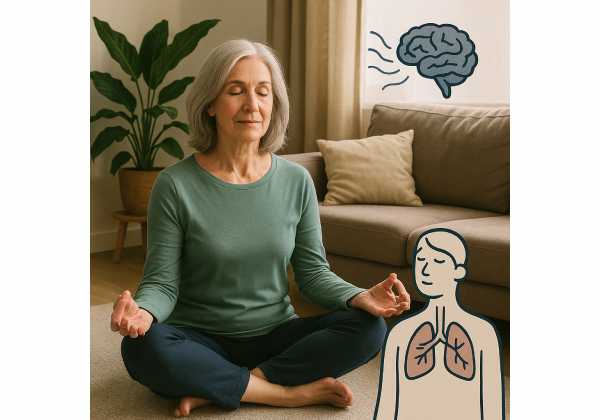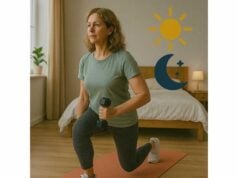
As we age, many of us notice that stress lingers longer and sleep feels lighter. The biology behind that shift is not a moral failing; it is physiology. The hypothalamic–pituitary–adrenal (HPA) axis grows more reactive for some people, and circadian cues can blur with irregular light, caffeine, and social schedules. Meditation and mindfulness help by training attention, softening stress responses, and creating a reliable path to calm. In this guide, you will learn how the HPA axis influences sleep in midlife, which meditation styles fit common patterns (restless mind, body tension, social stress), and how to build a realistic daily practice. You will also find ways to pair mindfulness with breathwork and evening light hygiene, and a simple framework to track benefits over two to four weeks. To round out your self-care plan, visit our pillar on sleep, stress and recovery strategies.
Table of Contents
- Stress, the HPA Axis, and Why Sleep Suffers with Aging
- Mindfulness, Body Scan, and Loving Kindness: Core Styles
- Evidence for Sleep, Anxiety, and Pain in Midlife
- Daily Practice Design: Micro Sessions and Anchors
- Pairing Meditation with Breathwork and Evening Light Hygiene
- Common Pitfalls and How to Stay Consistent
- Measuring Impact: Sleep Quality, HRV, and Mood
Stress, the HPA Axis, and Why Sleep Suffers with Aging
The HPA axis is the body’s primary stress-response network. When it detects threat, real or perceived, it signals a cascade: the hypothalamus releases corticotropin-releasing hormone (CRH), the pituitary releases adrenocorticotropic hormone (ACTH), and the adrenal glands release cortisol. Cortisol helps mobilize energy and sharpen attention. That is adaptive at noon when challenges appear; it is unhelpful at midnight when the goal is recovery.
In midlife and older adulthood, several factors tilt this system toward overdrive. First, chronic low-grade stress accumulates—caregiving, work transitions, financial strain, health concerns. Second, circadian cues can drift: later meals, prolonged evening light, irregular sleep–wake times. Third, sleep becomes more fragile: less slow-wave sleep, more awakenings. Together, these changes create a loop: stress lightens sleep, lighter sleep heightens stress sensitivity, and the cycle reinforces itself.
Meditation and mindfulness target this loop by training attentional control and non-reactivity. Instead of automatically elaborating on worries, you notice sensations, thoughts, and emotions as passing events. Over time, that stance reduces rumination, dampens the stress response, and allows cortisol to follow a healthier day–night pattern. Physiologically, people often report a felt sense of “more room” between trigger and reaction, plus earlier signs of relaxation: slower breathing, looser jaw and shoulders, and a more stable heart rhythm during the pre-sleep window.
Understanding how stress interferes with sleep helps you choose when to practice. If your issue is a restless mind at bedtime, a brief “unwinding” session in the evening is useful. If you wake at 3–4 a.m. with a racing mind, work upstream: morning or afternoon sessions lower the day’s cumulative arousal. If daytime stress erupts in short bursts, micro-practices—two to five breaths with attention—can keep the HPA axis from stacking up tension that later disrupts sleep.
Finally, remember that meditation is not about suppressing thoughts. It is a skills program: noticing, letting be, returning. Those skills generalize to family conversations, medical appointments, and the moments before lights-out when the mind tries to solve tomorrow’s problems. That is the terrain where calmer physiology—and better sleep—grows.
Mindfulness, Body Scan, and Loving Kindness: Core Styles
Not all meditation feels the same. Choosing a method that fits your temperament and sleep barriers makes consistency far easier. Three styles serve most aging adults well: mindfulness of breath/senses, body scan, and loving kindness (metta). You can rotate them or double down on the one that clicks.
Mindfulness of breath or senses (10–12 minutes).
You place attention on a simple anchor—breath at the nostrils, the rise and fall of the abdomen, or ambient sounds. When the mind wanders, you notice and return without judgment. This practice strengthens meta-attention (the ability to notice attention leaving) and reduces rumination. For sleep, use it in the early evening as part of a wind-down: sit upright, eyes soft or closed, notice five full breaths, then settle into regular breathing. If you feel drowsy early, shorten the session; the goal is calm, not grogginess on the couch.
Body scan (10–20 minutes).
You move attention through the body—crown to toes or toes to crown—observing sensations: temperature, pressure, tingling, no sensation. The scan trains interoceptive awareness and non-reactivity to discomfort. It’s excellent for people who carry tension in the jaw, shoulders, hips, or who wake with a “wired body, tired mind.” To tailor it for aging bodies, give extra attention to areas with chronic pain. Let sensations be as they are; adjust posture if pain spikes, then resume the scan. Many find a shorter scan (8–12 minutes) before bed helps the body “hand over” to sleep.
Loving kindness (metta) (5–10 minutes).
You silently offer brief phrases of goodwill: “May I be safe. May I be healthy. May I live with ease.” You then extend those wishes to a loved one, a neutral person, and, when ready, a difficult person. Metta can soften anger, social stress, and self-criticism—frequent late-night agitators. If your awakenings are tied to stressful relationships or caregiving, metta may be the missing piece.
How to choose.
- Restless, ruminative mind: Start with mindfulness of breath; add metta on high-stress days.
- Body tension or pain: Lead with body scan; keep sessions brief to prevent frustration.
- Loneliness or irritability: Use metta three or four evenings per week; it often shifts mood tone more quickly than people expect.
You can also layer these styles into a single, short routine: two minutes of mindful breathing, five minutes of body scan, one minute of metta. If screens and evening light are an issue for you, pair practice with simple light habits from our guide to screen hygiene at night so your physiology and environment work in the same direction.
Evidence for Sleep, Anxiety, and Pain in Midlife
The research on meditation for sleep and stress in midlife is broad and evolving. Three patterns stand out.
1) Sleep quality improves modestly but meaningfully.
Randomized trials in older adults with moderate sleep disturbance have shown that structured mindfulness programs can reduce Pittsburgh Sleep Quality Index (PSQI) scores more than active controls such as sleep education. Effects often emerge within six to eight weeks and include shorter sleep latency, fewer awakenings, and better next-day functioning. While not all studies show large gains, the direction is consistently positive. Importantly, benefits tend to persist when participants continue brief home practice, even after group sessions end.
2) Anxiety and stress reactivity decline, with spillover benefits for sleep.
Mindfulness training reduces trait anxiety and perceived stress in varied adult populations. This matters because stress reactivity—not just the total number of stressors—predicts night-to-night sleep disruption in midlife. People often report fewer “spirals” at lights-out and a faster return to sleep after nocturnal awakenings. Objective measures sometimes lag subjective improvements, but stress markers and sleep satisfaction generally move together over weeks.
3) Pain outcomes improve, helping sleep indirectly.
Chronic pain and fragmented sleep reinforce each other. Mindfulness reduces the affective component of pain—the suffering layered on top of sensation—by changing how attention interacts with discomfort. Many participants describe the shift as “more space around the pain,” which can reduce catastrophizing and make bedtime more comfortable. Because even small pain reductions can cut nighttime awakenings, this pathway is practical for older adults with osteoarthritis, back pain, or neuropathy.
What the evidence does not show.
Meditation is not a sedative, and it is not a quick fix for severe insomnia or untreated medical issues such as sleep apnea. Insomnia-specific cognitive and behavioral therapy (CBT-I) remains first-line for chronic insomnia; meditation can complement it or prepare you to engage with it more effectively. If you need a structured step-by-step for insomnia skills, see our practical guide to CBT-I tools in midlife.
Bottom line for aging: Expect moderate improvements in subjective sleep and stress within one to two months if you practice most days. The people who benefit most have stress-reactive insomnia, light to moderate pain, or rumination at bedtime. Use the methods in this article to personalize your practice and track changes, so you can keep what works and drop the rest.
Daily Practice Design: Micro Sessions and Anchors
A sustainable practice is less about willpower and more about design. Short, reliable sessions—tied to natural anchors—beat long, occasional bursts. Use the steps below to build a routine that your future self will keep.
Step 1: Choose your default slot.
- Morning (best for daytime calm): Right after you brush your teeth or boil water for tea. Ten minutes of mindfulness sets a steady tone, often improving attention and mood through the afternoon.
- Late afternoon (best for evening wind-down): Before dinner or before changing into comfortable clothes. This slot reduces evening rumination and eases the transition to bedtime.
- Early evening (best for pre-sleep relaxation): Ninety to sixty minutes before lights-out, not in bed. Think of it as the start of your wind-down routine.
Step 2: Start shorter than you think.
Aim for 8–12 minutes for mindfulness or body scan, 5–10 minutes for loving kindness. If you only have five minutes, use them. Consistency beats duration for HPA axis training.
Step 3: Add micro sessions.
Sprinkle 30–90 second resets during the day to prevent stress from stacking. Examples: before a meeting, after a difficult call, when you park the car. The micro script: notice breath for five cycles → relax shoulders and jaw → feel feet or palms → identify one sound. These short practices lower arousal so bedtime is not a mountain to climb.
Step 4: Use anchors you already do.
Tie practice to stable actions so you do not rely on memory: start after setting the kettle, after a walk, or immediately post-shower. A visible cue (folded meditation cushion, a sticky note on the lamp) helps.
Step 5: Plan context guards.
- Posture: Sit upright or lie down only if pain requires it. If you fall asleep in practice, move earlier in the day.
- Phone: Airplane mode or do-not-disturb; timer only.
- Environment: Dimmed lights, cool room; keep a light blanket for body scans if you tend to chill.
Step 6: Track the smallest possible metrics.
Each day, note minutes practiced, method used, and pre-sleep stress (0–10). That log makes progress visible and supports honest tweaks.
If you want to augment practice with non-supplement, non-drug levers, a simple paired routine is powerful: brief mindfulness plus two minutes of slow nasal breathing. For a clear breakdown of 4-7-8 and box breathing patterns, see our guide to breathwork for sleep and stress.
Pairing Meditation with Breathwork and Evening Light Hygiene
Meditation is the skill; your environment is the amplifier. The body takes cues from light, temperature, and breathing rate. Align these with your practice to calm the HPA axis and reinforce sleep pressure.
Breathwork as a downshift gear.
Slow, low, and through the nose is the rule. Two simple patterns dovetail with mindfulness:
- 4-7-8 breathing (4 inhale, 7 hold, 8 exhale) for 4–6 cycles. Lengthening the exhale stimulates the parasympathetic system and moves heart rate variability (HRV) toward greater vagal influence. Use it after a mindful check-in or when you sense a spike in arousal at night.
- Box breathing (4-4-4-4) for 2–3 minutes. Even counts build steadiness. It suits people who dislike long breath holds and pairs well with metta.
Evening light hygiene for circadian alignment.
Light is the most potent external signal for your body clock. After sunset, shift from bright, overhead light to softer, lower, and warmer light. Put bright screens on night modes and reduce visual contrast. If you are sensitive to screen exposure, move your last screen interaction 60–90 minutes before bed. Combine light changes with a short mindfulness session to mark the transition from “doing” to “settling.” For more practical steps, see our playbook on resetting your body clock.
Temperature and movement.
A warm shower followed by a cool bedroom (~18–19°C) encourages heat loss and sleepiness. Pair that shower with a five-minute body scan as you dry off to notice muscles releasing. Late vigorous exercise can lift core temperature and alertness; if you train in the evening, add a brief mindfulness session plus slow breathing to ease the shift into rest.
Food, caffeine, and alcohol timing.
A light, earlier dinner and avoidance of alcohol in the last three hours before bed help meditation “stick.” Caffeine has a long half-life; even afternoon cups can collide with bedtime calm. If you are tuning these levers, our guide on timing for stimulants and late meals offers clear guardrails to protect sleep.
A simple 60-minute wind-down stack:
- T-60: Lights dim; 6 minutes mindful breathing; write tomorrow’s top three tasks.
- T-45: Warm shower; room set to 18–19°C.
- T-30: 8–10 minute body scan; 1 minute metta.
- T-15: Low stimulation reading or gentle music; no problem-solving.
- Lights-out: Consistent time, consistent cue (lamp off, curtain closed).
The point is not perfection. It is a repeatable rhythm that makes calm the default, so sleep can do what it does best: repair.
Common Pitfalls and How to Stay Consistent
Consistency wins, but a few traps derail even motivated people. Here is how to sidestep them.
Pitfall 1: Chasing “no thoughts.”
Meditation is not thought deletion; it is noticing and returning. Expect wandering. Each gentle return is the training rep. If restlessness spikes, shorten sessions and add two or three micro resets during the day to reduce pent-up arousal.
Pitfall 2: Going too long, too soon.
Starting with 20–30 minutes daily often backfires. Use 8–12 minutes and add a minute every week if you like. On rough days, do two minutes to keep the chain intact.
Pitfall 3: Practicing only at bedtime in bed.
Bed is for sleep and closeness. Meditation in bed conditions wakefulness in your sleep space. Practice upright in a chair before your wind-down; if pain requires lying, use a couch or yoga mat, then move to bed when truly sleepy.
Pitfall 4: All-or-nothing perfectionism.
Missed a day? Begin again the next. Ten minutes today beats thirty tomorrow that never happens. Use a simple habit loop: cue → practice → reward. The reward can be small: a favorite tea or two minutes of a relaxing track.
Pitfall 5: Expecting meditation to overpower social jet lag.
If weekends swing your schedule by two hours, your body clock will fight back. Meditation helps tolerance but cannot replace consistent timing. If this resonates, read our brief guide on sleep hygiene basics and shift by 15–20 minutes per day toward a stable anchor.
Pitfall 6: Ignoring pain and posture.
Aches sabotage attention. Use supportive cushions, a rolled towel in the low back, or practice lying down if needed. For longer body scans, keep knees supported and hands warm; cold fingers can become the only thing you notice.
Pitfall 7: Judging progress only by “perfect nights.”
Look for earlier wins: lower pre-sleep stress (0–10 scale), fewer minutes of tossing, quicker recovery after a 3 a.m. awakening, or better morning mood. Those are real gains that often show up before big changes in total sleep time.
Pitfall 8: Tool overload.
Multiple apps, trackers, and protocols can swamp attention. Start with one method, one time of day, and a two-line log. Add complexity only if a clear need appears.
Remember that mindfulness is not about becoming a different person; it is about relating to your experience with a steadier hand. That steadiness translates well to the evenings, when small provocations can otherwise keep the HPA axis humming.
Measuring Impact: Sleep Quality, HRV, and Mood
A short trial—two to four weeks—lets you see whether meditation meaningfully shifts your nights and days. Keep the measures simple, the routine steady, and decisions clear.
Set your baseline (Day 0–2).
Record three days of usual sleep and stress without changing anything. Capture:
- Bedtime and wake time (clock times).
- Sleep latency (minutes to fall asleep).
- Night awakenings and minutes awake (estimate is fine).
- Pre-sleep stress, morning energy, and mood (0–10 scales).
- Daily practice minutes (if any).
Run a two-week practice block.
Pick one primary method and slot—example: 10 minutes mindfulness at 6:30 p.m., plus two 60-second daytime resets. Keep caffeine timing, alcohol, and light routines stable. If you are also working on broader circadian alignment, our overview of morning light and evening darkness can help you lock in anchors while you measure.
What to track nightly (1 minute).
- Practice minutes and method (e.g., “10 min mindfulness + 1 micro”).
- Pre-sleep stress (0–10) and bedtime.
- Sleep latency, awakenings, and estimated total sleep time.
- Morning energy and mood (0–10).
Optional: a one-line note about context (“late meeting,” “knee pain,” “travel”).
Wearable data: use sparingly.
If you use a tracker, focus on sleep latency, awake after sleep onset, and overnight heart-rate nadir. HRV can help, but it is noisy. Look for directional trends week over week, not nightly perfection. If your HRV rises slightly and resting heart rate dips while subjective stress and latency improve, you are on track. For perspective on what HRV can and cannot tell you about recovery, see our primer on interpreting HRV in aging.
Decision rules at two weeks.
- Clear benefit: Pre-sleep stress down ≥2 points, latency down ≥15 minutes, or wake time less fragmented. Continue for two more weeks to consolidate.
- Partial benefit: Keep the method and add a 5-minute metta or brief body scan three evenings per week.
- No benefit: Switch method (e.g., from breath mindfulness to body scan), adjust timing earlier, or address a higher-leverage factor (evening light, caffeine, late meals).
When to seek additional help.
If you snore loudly, stop breathing during sleep, or feel unrefreshed despite 7–8 hours in bed, get screened for sleep apnea. If depression, trauma, or severe anxiety dominate evenings, combine mindfulness with clinical care. Meditation supports healing, but it is not a substitute for diagnosing and treating underlying conditions.
Your aim is a minimal effective routine that fits your life and steadily reduces stress load across the day. That is the recipe for calmer physiology at night, and better days ahead.
References
- Mindfulness-Based Interventions and the Hypothalamic–Pituitary–Adrenal Axis: A Systematic Review (2024) (Systematic Review)
- Mindfulness Meditation and Improvement in Sleep Quality and Daytime Impairment Among Older Adults With Sleep Disturbances: A Randomized Clinical Trial (2015) (RCT)
- Effects of mindfulness-based cognitive therapy on older adults with sleep disorders: a systematic review and meta-analysis (2023) (Systematic Review and Meta-analysis)
- The effect of mindfulness meditation on sleep quality: a systematic review and meta-analysis of randomized controlled trials (2018) (Systematic Review and Meta-analysis)
Disclaimer
This article is educational and does not replace personalized medical advice, diagnosis, or treatment. Speak with your clinician before starting any new practice if you have significant anxiety, depression, pain conditions, cardiovascular disease, sleep apnea symptoms, or if you are adjusting medications that affect sleep or mood. If you experience persistent insomnia, daytime sleepiness, or safety concerns (e.g., drowsy driving), seek a formal evaluation.
If this guide helped you, please consider sharing it on Facebook, X, or any platform you prefer, and follow us for future updates. Your support helps us continue creating careful, high-quality content.










